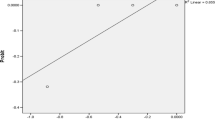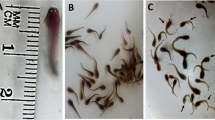Abstract
The present study was aimed at applying condition factor (CF), brain acetylcholinesterase (AChE) and gill histology as biomarkers for detecting possible exposure/effect induced by pesticides in fish residing rice field associated waterbodies in Sri Lanka. Biomarkers of an indigenous fish, Rasbora caverii collected from five sampling sites including canals near rice fields, a river and a reservoir (the reference site) were evaluated at four sampling stages covering pesticide application periods during rice cultivation season in 2004. Results indicated that CF of the fish did not show significant alterations regardless of the sampling sites or sampling stages. Site specific differences in AChE activities of the fish were not evident either prior to application of pesticides or at 7 days after Paraquat application to the rice fields. Two days after the application of a mixture of Fenthion and Phenthoate to the rice fields, AChE activity of the fish collected from canals near rice fields was significantly depressed (65–75%) compared to the fish in the reference site. The activities remain depressed to 50–56% even at 65 days after the insecticides application. Laboratory studies showed that prior exposure of R. caverii to Paraquat (2 μg l−1, 7 days) enhanced the extent of inhibition of brain AChE activity induced by Fenthion (3 μg l−1) or a mixture of Fenthion (3 μg l−1) and Phenthoate (5 μg l−1). Gills of fish collected from canals near rice fields exhibited abnormal multiple divisions at the tips of some secondary lamellae in addition to hyperplasia, hypertrophy and club shaped deformities. Results indicate that application of pesticides in rice culture could manifest a threat to native fish populations residing rice field associated waterbodies. The response of brain AChE and histological changes in the gills of R. caverii allowed differentiating sampling sites after insecticide applications to the rice fields. Hence, R. caverii may be considered as a surrogate species in ecotoxicological risk evaluation of agrochemicals in the region.



Similar content being viewed by others
References
Al-Omar MA, Al-Suhaily RH, Kamel Y (2004) Distribution and dissipation of Phenthoate insecticide following aerial application. Bull Environ Contam Toxicol 73:825–831
Bucke D (1989) Histology. In: Austin B, Austin DA (eds) Methods for the microbiological examination of fish and shellfish. Ellis Horwood Limited, West Sussex
Brown CD, Carter AD, Hollis JM (1995) Soil and pesticide mobility. In: Roberts TR, Kearney PC (eds) Environmental behaviour of agrochemicals. Wiley, West Sussex
Coppage DL, Bradeich E (1976) River pollution by anti-cholinesterase agents. Water Res 10:19–24
De La Torre FR, Ferrari L, Salibián A (2005) Biomarkers of a native fish species (Cnesterodon decemmaculatus) application to the water toxicity assessment of a peri-urban polluted river of Argentina. Chemosphere 59:577–583
De Mel GWJLMVTM, Pathiratne A (2005) Toxicity assessment of insecticides commonly used in rice pest management to the fry of common carp, Cyprinus carpio, a food fish culturable in the rice fields. J Appl Ichthyol 21:146–150
Di Marzio WD, Tortorelli MC (1994) Effects of paraquat on survival and total cholinesterase activity in fry of Cnesterodon decemmaculates (Pisces, Poecillidae). Bull Environ Contam Toxicol 52:274–278
Ecobichon DJ (1992) Toxic effects of pesticides In: Amdur M, Doull J, Klaassen C (eds) Casarett and Doull’s toxicology. The basic science of poisons. McGraw-Hill, New York, pp 565–622
Ellman GL, Courtney KD, Anders V Jr, Featherstone RM (1961) A new and rapid colourimetric determination of acetylcholiesterase activity. Biochem Pharmacol 7:85–95
Fanta E, Rios FS, Romão S, Vianna ACC, Freiberger S (2003) Histopathology of the fish Corydoras paleatus contaminated with sublethal levels of organophosphorous in water and food. Ecotoxicol Environ Saf 54(2):119–130
Fulton MH, Key PB (2001) Acetylcholinesterase inhibition in estuarine fish and invertebrates as an indicator of organophosphorous insecticide exposure and effects. Environ Toxicol Chem 20:37–45
Gruber SJ, Munn MD (1998) Organophosphate and carbamate insecticides in agricultural waters and cholinesterase inhibition in common carp (Cyprinus carpio). Arch Environ Contam Toxicol 35:391–396
Khan MAQ (1977) Pesticides in aquatic environments. Plenum Press, NY
Kozlovskaya VI, Mayer FL, Menzikova OV, Chuyko GM (1993) Cholinesterase of aquatic animals. Rev Environ Contam Toxicol 132:117–142
McCarthy JF, Shugart LR (1990) Biomarkers of environmental contamination. Lewis Publishers, FL
Murty AS (1986) Toxicity of pesticides to fish, vol 2. CRC Press Inc., Boca Raton, FL
Nemesók J, Orban L, Asztalos B, Buǵas ZS, Nemeth A, Boross L (1985) Investigations on paraquat toxicity in fishes. Water Int 10:79–81
Pathiratne A (1999) Toxicity of Fenthion in Lebaycid to tilapia, Oreochromis mossambicus (Peters): effects on survival, growth and brain acetylcholinesterase activity. J Natl Sci Found Sri Lanka 27(2):79–91
Pethiagoda R (1991) Freshwater fishes of Sri Lanka. Wildlife Heritage Trust of Sri Lanka, Sri Lanka
Post G (1985) Text book of fish health. T. F. H. Publications Inc., Neptune City, NJ
Van der Oost R, Beyer J, Vermeulen NPE (2003) Fish bioaccumulation and biomarkers in environmental risk assessment: a review. Environ Toxicol Pharmacol 13:57–149
Wauchope RD, Buttler TM, Hornsby AG, Augustijn-Beckers PWM, Burt JP (1992) SCS/ARS/CES Pesticide Properties data base for environmental decision-making. Rev Environ Contam Toxicol 123:1–155
Whitehead A, Anderson SL, Ramirez A, Wilson BW (2005) Cholinesterase in aquatic biomonitoring: assay optimization and species specific characterization for a California native fish. Ecotoxicology 14:597–606
Zar JH (1999) Biostatistical analysis. Prentice Hall, Upper Saddle River, NJ
Author information
Authors and Affiliations
Corresponding author
Rights and permissions
About this article
Cite this article
Wijeyaratne, W.M.D.N., Pathiratne, A. Acetylcholinesterase inhibition and gill lesions in Rasbora caverii, an indigenous fish inhabiting rice field associated waterbodies in Sri Lanka. Ecotoxicology 15, 609–619 (2006). https://doi.org/10.1007/s10646-006-0101-5
Received:
Accepted:
Published:
Issue Date:
DOI: https://doi.org/10.1007/s10646-006-0101-5




